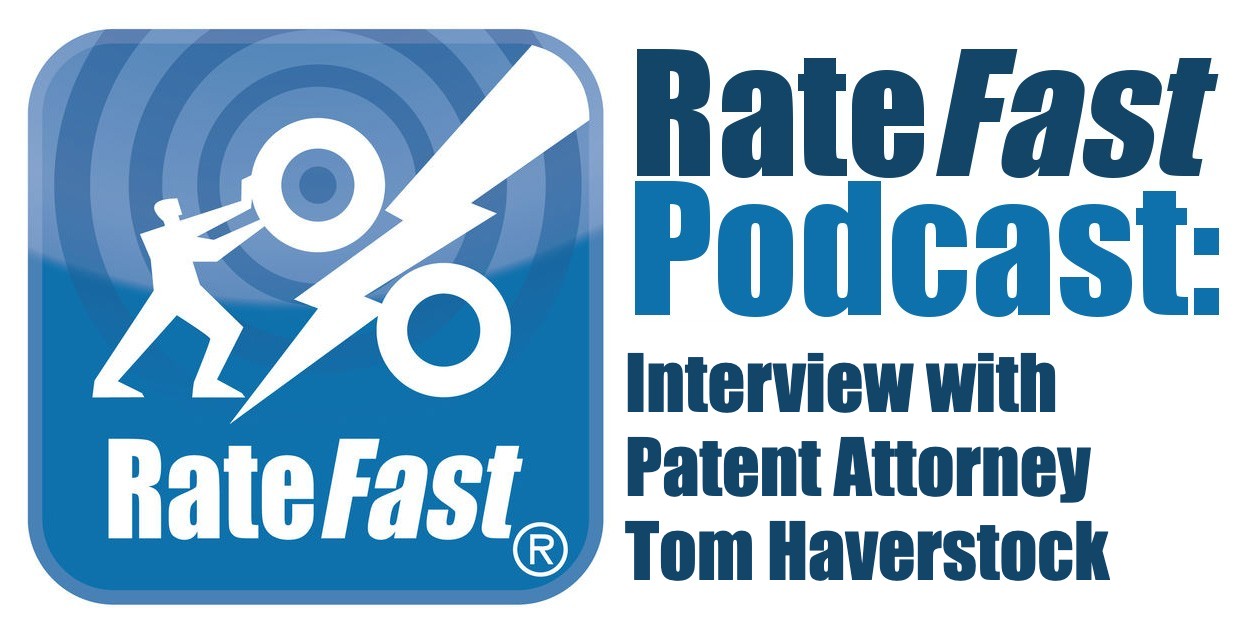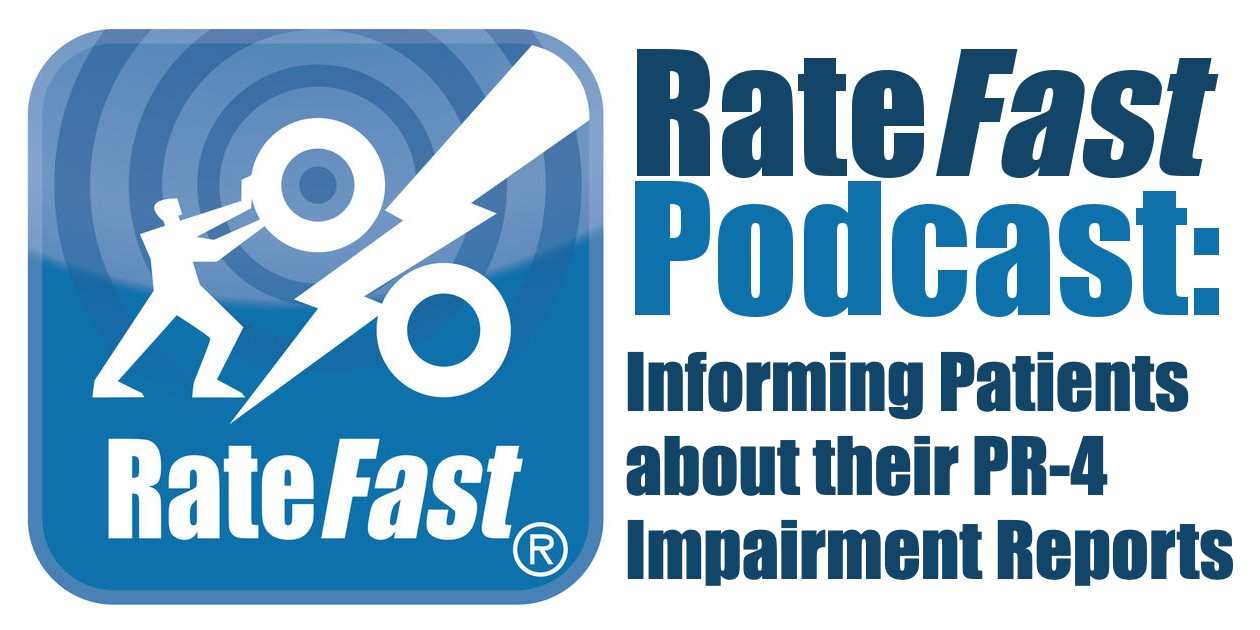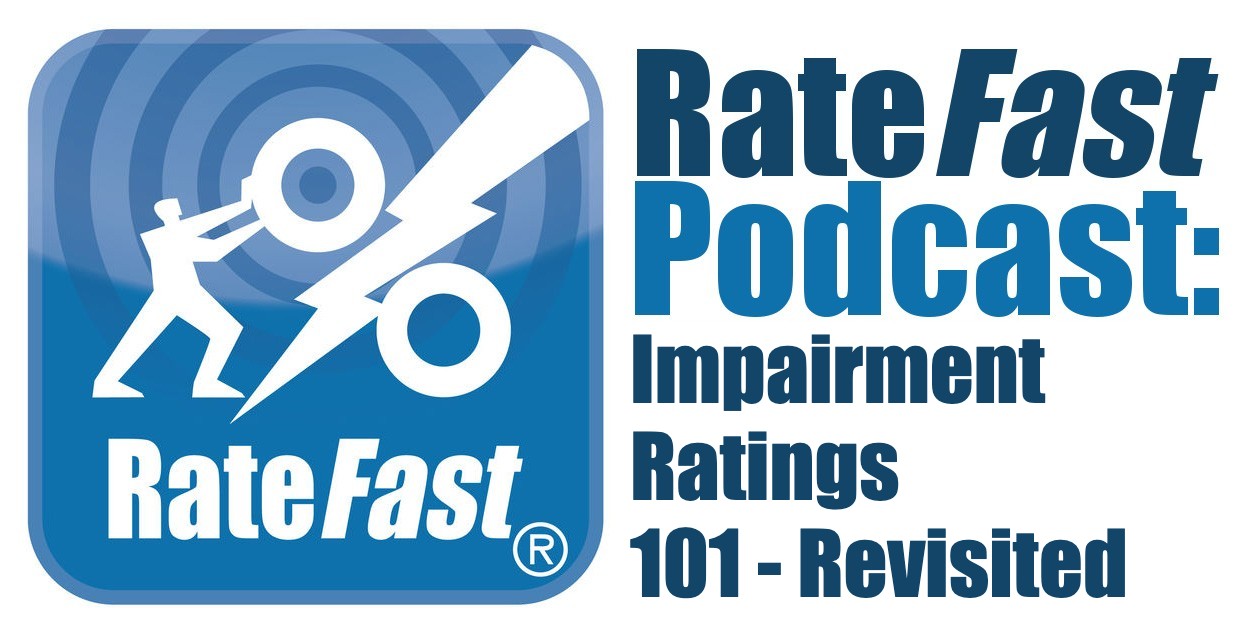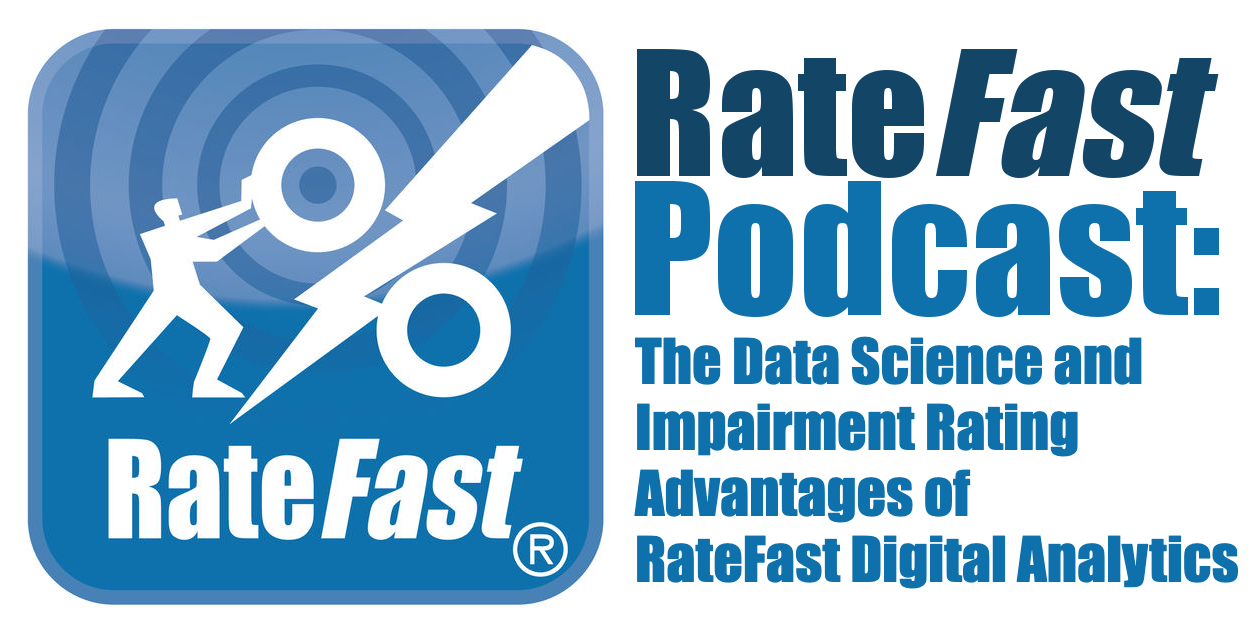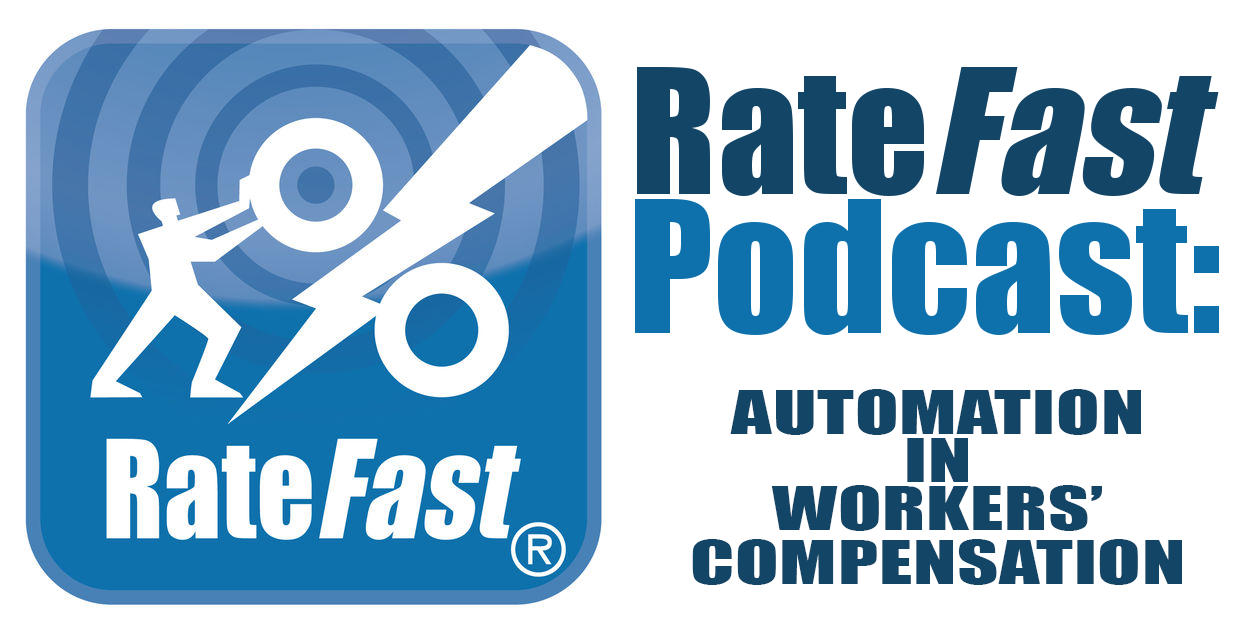We’re in the age of data! Data helps us improve things in our day to day life, as well as track the progress of our ventures. Data analytics could be incredibly helpful to workers’ compensation as a whole, we know because we’ve seen it. Dr. John Alchemy expands on RateFast data analytics and how it helps close workers’ compensation claims.
For more information on this episode, and other helpful tips about workers’ compensation, visit the RateFast Blog.
If you’re a workers’ compensation provider, adjuster, or case manager check out RateFast Express: the service that writes your impairment reports for you!
RateFast Podcast: The Data Science and Impairment Rating Advantages of RateFast Digital Analytics
Cory Oleson (Host): Hello and welcome again to the California workers comp report. Today is Monday, July 12 2021. This is your host Cory Oleson here with Dr. John Alchemy to discuss the data science and impairment rating advantages of great fast digital analytics.
How are you today, John?
Dr. John Alchemy: Hey, Cory doing great. Good to be back and good to chat.
Cory: Yeah, we’re back in the saddle again. A little a little update about last week’s episode. And this is not at all relevant to anything. But I did tell that I saved this for the episode, by the way, because I wanted to tell tell you and our listeners that I told a joke about cantaloupes last episode. And, you know, for those listening, you will know and for those who don’t know, I recommend the episode. But since I’ve had multiple opportunities to tell that joke, that it was just sort of like well, here’s the cantaloupe joke, again, all to different people. And I don’t know why, but it’s just a cosmic thing that I felt I had to, to mention it being the podcast being the first place, I want to say, this year that I told the, the jokes.
Dr. John Alchemy: It’s a good play to the wider audience, Cory.
Cory: Um, a lot better than some of the jokes. Okay. So today, onto the topic, the data science and impairment rating advantages of re pass digital analytics. We’re talking about basically the things that make RateFast incredibly powerful. And the reason that is still something that we highly recommend is because we’ve been waiting for anybody else to catch up in terms of doing what we do and doing it well and correctly. But in order to have any sort of idea or point of reference for how it’s how it’s good, and how it works in anything, we do need to know how it works.
So first off, John, if we’re talking about, you know, RateFast digital analytics, then what is it that we’re talking about?
Dr. John Alchemy: Well, you know, when we do impairment rating, across impairment rating, in whatever state you are, or in California, the two main things that are really, the basis or the foundation, if you will, is being able to have someone take a look at a report and know the integrity of it. Now, we’ve done other podcasts on data integrity. So you know, I’ll refer the listeners there to what data integrity is, but in short, it’s a quick score of what is in your report, and what isn’t.
And I’ll tell you, you know, a lot of impairment rating, as you alluded to earlier, is basically Stone Age, you know, it’s 1000 different people doing impairment ratings, 1000 different ways with different levels of you know, quality and scoring, and then throwing in the variable that I love, my clinical experience, that just kind of smears the edges of a rating and really doesn’t hold anyone you know, responsible in in a meaningful way that can be checked, or that can be compared against the next report that person does, or the same patient that’s reported on by a different provider.
There’s, just no way for the stakeholders to take a look at a report and say, you know, this doctor A did a 60% data integrity and his report, and this Dr. B, did a 78% integrity on her report. And it’s just crazy for the size of the market, and the money that’s at stake. And all of the cases in California that get rated every year. It’s just mind boggling to me that you know that it works or doesn’t work in the present system.
And I’ve talked about this previously that unfortunately, because the impairment rating has been such a black box or such a curtain with the Wizard of Oz behind it, that the stakeholders, mainly insurance adjuster and patients are left only to value reports based on the result of the impairment and a subjective gut check on what they think is fair or not fair. And that’s the big problem with the system. This system was set up so it stopped being a subjective, you know, quote unquote, gut check, impairment rating where you know, one person would say, oh, yeah, this is a great rating and the other one says, no, this is totally off base because that’s the way it used to be. But unfortunately, when we brought in the AMA Guides, no one has ever thought to create a system that’s like, hey, now that we have, you know, certain clear elements and report that are to be used for rating, why aren’t we tracking them? And why do we have no tool that will give us insight into the report?
So, you know, the data integrity with RateFast analytics is a huge benefit for stakeholders. And, you know, I absolutely love it, we’ve had these inner reports now for maybe 8 to 12 months. And I can’t tell you how valuable it is when someone brings up a complaint, or when someone wants to bring up a challenge on RateFast report, and they have some other report they’re pointing to and you say, okay, well, the RateFast for this provider found a fun and integrity rating of 78%, what’s the integrity of the report in your hand? And then you just hear crickets and a bunch of silence, because they don’t know. And, you know, that’s really what I want to do with rate fast and advancing technology. Is let’s get this into some type of transparent system. So we’re not wasting everyone’s time. And right now, there is a lot of wasted time and money in this space.
Cory: Absolutely, absolutely. You know, anybody that works in any sort of industry will tell you, you know, they, they sort of understand that there’s a totally nitty gritty side of it, which anybody that works outside of that industry, especially if it interfaces with the public in any sort of way. You know, if you ask anybody that doesn’t know about this industry at all, they they’re not aware of how inefficient this just gigantic thing actually is, I mean, work on being only one example of that, I mean, the other thing that comes to mind, is sort of like the way that people talk about AI, like the any sort of user that’s interfacing with Internet of Things product, there’s something things that there’s some sort of, you know, genius world of digital infrastructure behind sort of a lot of the things that they use, which is, in a lot of ways true, but sort of some of the, the tables are being held up by napkins, sometimes there’s things like that, um, and if you work in an industry that doesn’t have, you know, things that are sort of obscured from the public eye that are just messy than we were, I’m dying to know what industry works well.
But yeah, that said, we’ve had a previous episode about data integrity, which I, which I also recommend, and it’s essentially kind of solving this issue of you have this huge, bloated system where everybody that works in it is aware that it doesn’t work great, or at least to the point where people are spending extravagant amounts of money just to solve problems that are inherent in the system. And yet, a lot of the time, people just live with these problems, because fixing a certain aspect is sort of like untangling a huge, you know, not in 10 different cords or wires or something, it’s just kind of at that at a certain point. It’s just like, it’s not my job. It’s, it’s this is, but we at RateFast made it our job. So in data integrity, things like that, ways to tell how good your information was, after you’ve handed it over, instead of just defaulting to well, this information is probably bad, this is probably going to be a mid legal case or something.
Dr. John Alchemy: Yeah, exactly. So the integrity, you know, is a huge piece of kind of understanding what’s there, what isn’t. The next piece that’s really big about this technology? Is the reporting internal reporting consistency, and scoring the ADLs. You know, again, we’ve talked about ADL values and how they play into impairment ratings, and how fundamental they are, and the AMA Guides, you know, multiple other podcasts. But um, when when you have a system that can now consistently process data and answers from patients and scoring from physicians, you have a tool that is going to consistently give you you know, a value based on what’s actually in the report. And I alluded to earlier in the podcast, you know, one of my most frustrating answers to hear or see written in like a QME report or an impairment report is well this is based on my medical experience. And I mean, that’s, I just don’t know what to say to that because it just it doesn’t mean anything.
Cory: Yeah, yeah. It’s it’s it’s pulling it’s it’s kind of like pulling the expert move or the professional move. I’m a professional but you’re speaking to other professionals who see right through it, or you know other professionals who are supposed to see right through it. Who didn’t, you know, whose job is to scrutinize your work and things like that. Yeah, it’s amazing how, how this could be sometimes if you think about you think about it, it’s kind of the way that I think about reports is that it’s almost like a, it’s almost like a pass fail grade for a test, where you have to solve like, one problem that’s made up of a bunch of, you know, small problems versus something like a, you know, this is what an impairment rating is, it’s like a holistic, sort of report on, you know, the human body and its injury and recovery. And it just seems like, just from what I hear, it seems like a lot of people treated almost as if it’s a kind of like a math test, where all the, all the questions are different questions, and you know, the answer to number one does not necessarily relate to the answer to number five, things like that. Not the case, we work on reports.
Dr. John Alchemy: Yeah, and I think the other difficulty with the marketplace is that I talked about, you know, price sensitivity, and people just having this subjective, you know, value in their head about what they want to pay for a knee or a shoulder, because that’s what they think they should have to pay for a knee and shoulder, not being able to see, you know, the data nuances between a shoulder one and a shoulder two case, you know, yes.
And, the big value of RateFast, is that, you know, when we tell you the value, it’s defensible. And it’s very clearly objectified in the report. So, you know, if we lay a number out, you know, one shoulder might be, you know, 4%, but the other one might be 15. And there’s a reason for that. And when you have that type of insight into the settlement of a report, it gives incredible power to the stakeholders that value consistency and objectivity. Because all of this, you know, my medical opinion, goes out the window, all the times that the Almaraz Guzman rating might be abused, for whatever reason, goes out the window. And, you know what the price is.
And so you can avoid the litigation or you can shorten the time of litigation, and you can promote a more equitable settlement than using this current system. Because I mean, think about it if you’re handed an invoice every month for the same service, and it’s wildly different between each month with no explanation.
Cory: Sounds like my electricity bill.
Dr. John Alchemy: Possibly, yes. I think that that’s excellent. You know, there’s no, I think, no rate hikes and times you use your electricity. It’s just all over the place. And it’s very difficult to understand impairment ratings the exact same way.
Cory: Yeah. Oh, absolutely. Absolutely. And so it’s, you know, it’s at least good to know what you’re paying for. And it’s good to have everybody to be in agreement that you’re paying for the right thing. So that’s kind of bringing it back around to what we’re doing. Um, so yeah, I mean, so the RateFast service, it’s important because it saves you time saves you money, it standardizes things, and it just takes care of a problem that was a problem that was too big for any, you know, one person that sort of in it and of it to tackle at the time because you know, it’s your job to see the patient or it’s your job to you know, read these reports or it’s your job to adjudicate these these issues and everything, so we did the job that everybody else is stupid to do.
Dr. John Alchemy: And most importantly, we’re still doing the job, you know, we’re still stopped but you know, at least we have a framework and a system and, you know, another example is, um, you know, the whole Almaraz Guzman thing, and the whole Almaraz Guzman thing currently, is prefaced on, you know, my medical opinion. And like I said, that’s a non starter for me, you know, to read that in a report yet, you know, the Almaraz Guzman was created because there was a sense that the impairment ratings were not always an accurate reflection of the individual’s functional loss, and I’m totally on board with that they weren’t. And part of the reason that they weren’t is because the integrity was not consistently in one report to the next or pieces one through five or in this report and pieces, you know, three through seven were in this report, and it was all over the place.
But the problem was, is that the Almarez Guzman was just thrown out there. But again, as we’ve discussed in prior podcasts, no instructions, you know, no basis for how it’s really used, you know, no guideline. But RateFast has proprietary algorithms. So we can take a look at it and anchor the value of that claim based on what I call the ADL functional loss, which is really what the ADLs are all about. They’re the things being rated in the AMA Guides and ranges of motion and strength and blah, blah, blah, are basically there to match up with what’s your functional loss is. And so we have that ability to say, here’s what came in, here’s your integrity, here’s your rating. And then here’s what the rating should be based on the functional loss. And then we can very simply tell, hey, this rating is within tolerance or not. And if it’s out of tolerance, here’s how many points it has to be adjusted to become intolerance.
So, you know, either way, you’re going to win with a system like that, because you have, you know, an expectation that’s pinned, and then you see where the exam comes in. So, you know, it’s so it’s a very interesting system, I call it the belt and suspenders of impairment rating, because either way, you’re going to get an accurate rating that you can use. It’s, it’s just a question of, you know, what the examiner is claiming, is the reasonable data in the exam?
Cory: Yeah. So when I, you know, if I say something like data scoring, intake and vector creation, for the AMA Guides, work comp isn’t the first thing that necessarily comes to mind. But it is something that is absolutely crucial in RateFast. Could you describe these things and how they work, John?
Dr. John Alchemy: Yeah, so, you know, data scoring is something that we’ve really been working on for the last couple of years. And you know, making sure that the way we process and intake data from an impairment report is consistent from report to report. And I’m going to take just a little sidebar here and step out and say, I think eventually what needs to happen in the space of impairment rating is that it needs to be brought into a digital environment, like we’re building as opposed to letting people just make up ratings off the cuff. And with varying levels of understanding, I’ve talked about this multiple times, the qualified medical evaluator in California has absolutely no testing to prove that they have any competency and impairment rating.
Yet, for some reason, the marketplace seems to think that you know, QMEs do better ratings in the PTPs. But, you know, not necessarily the case at all. And it’s just one of these big myths that have been propagated, you know, along with the system that, you know, has said, oh, well, we think, you know, for some reason, the QME has a magical better understanding of impairment rating than the primary treaters. But I mean, if you pull the curtain back, there isn’t one question. On the, you know, that the QME test about how to do an impairment rating, it doesn’t even ask you the color of the textbook.
Cory: Yeah. I’ve been reading edition six this whole time, I just figured I should buy the new one when it came out. That’s to those who don’t know, who are listening. That’s because California still uses the AMA Guides, fifth edition, where the sixth edition is currently out and used by other states. And as I’ve learned throughout the course of working with RateFast, people feel all kinds of ways about the new and the old editions and whether or not to use it at all. Different states don’t. Not all states, some states use old, you know, going back to the third edition states use versions of the AMA guide. So um, yeah, so there’s that. So what are the rating implications of brief, fast digital analytics? And, you know, the way that we use it advantageously?
Dr. John Alchemy: Well, I think one of the big benefits is, if you were, if I were to spread out, you know, three reports on the table from three different doctors. And I’m not gonna say that they were a QME or a PTP, let’s just say it was three impairment reports from three evaluators in the work comp system. You know, one report might say this patient has a 5 out of 10 pain 25% of the time, and can’t perform 7 of the ADLs on table one, dash two, okay. The next one might say, this patient has moderate pain and can’t perform most of their activities of daily living. That’s all you get in that one. And the third one might literally say this person and has back pain. Okay?
And that is the big issue here, when you’re looking at a series of reports, because if you have a system that can take these descriptions at varying levels, and put them all at the same vector, if you will, or measurable value for a pain, a frequency and an ADL, that’s really what this is all about. Because, you know, and I’ve seen reports from a QME that basically says the patient still has shoulder pain, that’s it, and the patient is working, modified duty. That’s the history, there’s nothing more than that. And this is a quote unquote, QME report.
And, you know, and so when you’re given that you have to make some type of understanding or sense of that, in the framework, have a digital analytic system, and you can, and this is the reason why trying to just get another provider and another rating, and another provider in another rating does not work, you know, because the next rating could be better, but it could be worse. And all it’s doing is delaying cases, minimizing the accuracy and the consistency. And again, why because people are looking for a number, instead of really looking at the data and saying, what should this really, you know, rate at, you know, what should this score be?
And what is the basis in this report, because it’s, it’s interesting, because the, the DWC, you know, has their impairment, raters to my knowledge, they have no standard, you know, infrastructure on how to interpret when someone says their pain is minor, or moderate, or 7 out of 10, or a 2 out of 10. You know, all they really do in my experience, is they look at the report and make sure that the doctor used the right table. And sometimes that’s even a little dicey with them. Because, you know, you could rate someone in a neurological chapter, you could rate them in the upper extremity chapter, you could rate them in the spine chapter and all be considering, you know, ratings of a nerve.
So, to me, the DWC results that I’ve seen are very superficial and very concrete. And they don’t really understand or they don’t appear to understand or discuss huge discrepancies in the data sets that are there in the reports. So they’re supposed to be there to help. And I think that maybe that’s their intention. But again, it appears to me as an outsider, having read, you know, many of these DWC, you know, quote, unquote, evaluation reports that, you know, they’re very limited in their scope and their understanding. And, you know, that they asked for, you know, maybe clarification sometimes, but, I mean, if you look at the stuff they’re actually asking, I think it often misses the big picture and is, you know, just focusing in on what we think you should use this table. You know, it’s just not a great oversight. Again, this is my opinion.
Cory: Yeah, totally. I mean, what you know, you get any thing that you buy a say it’s like a, you know, an electronic of sorts, or something like that, it’s going to be quality controlled. And then in an industry that has, you know, billions of dollars moving through it, you don’t get any sort of degree of quality control even though the people who are essentially it is their job to do so often. Don’t do it. So that’s a that’s always very reassuring. I’ll make sure I get injured at work as soon as possible so that I can go through this system.
So yeah. Okay, so let’s say I have made the decision to make my life the life of my patient, the life of the adjuster, the life of the employer and the life of everybody else a lot easier by doing such things as going with RateFast Express to write the impairment reports, and I receive the RateFast impairment report, or you know, if I wanted to see it back, because we also have an option of just letting us have it and putting it out of your life. So if you’re listening and you’re waiting for that in your life, then just run right down rate-fast.com right now, however, if you do still look at the report, or you know, you’re using RateFast for one of our other services, where will you see the calculations that we’ve described here today in the report?
Dr. John Alchemy: Well, each body part when it’s calculated with RateFast, you’re gonna see an analytics report at the very bottom, at the bottom line where it says, you know, the WPI of this shoulder is, you know, you’re going to see right below that you’re going to see what the data integrity is. And you’re also going to see what’s called the overage report. So those are, those are two very key metrics that, that if you understand the value, you can at least say, okay, I know this report has a minimal value of data in it that I’m willing to accept. Maybe that’s a 51% data mark, maybe it’s 75. You know, maybe it’s, you know, 90, whatever the stakeholders agree upon, either independently, but at least they can say, look, this rating has, you know, this amount of integrity in it.
And then the other big key is, they can look at the report, and very quickly see, how close is this report to spilling over into an Almaraz Guzman report, and I’m not aware of any reports that do this on a standardized objective level, like I said, it’s usually just goes to, you know, the provider saying, oh, in my medical opinion, the rating I provided in the four corners, does not rise to the Almarez Guzman requirement, and therefore we’re going to use this, you know, that’s basically the best you get. But when you’re doing a RateFast report, and if there is an overage or if the impairment load has exceeded the four corners rating, and remember that four corners rating is dependent on two things, the accuracy, and the amount of data that was actually collected for the report, we’re going to tell you exactly how much you’ve crossed the line, this rating has exceeded the four corners by 22%, 16%, 5%, 90%. You know, and so you at least know what you’re paying for.
And you know, that hey, look, this report, you know, shorted me 50% of the data set. And as a result, based on the patient’s functional loss, I know that you know, the individual has coming do a WPI of 17%. Okay, and that’s a very powerful thing to go into a settlement with, because no one else at the table is going to have that information as to 17%. The best you’re going to get is oh, it was the doctor’s, you know, medical opinion based on their experience, again, a total non starter from my standpoint. So you know, that is where you’re going to basically find the integrity. And you know, that borderline of crossing over into that, until now mysterious area of the Almarez Guzman ratings?
Cory:Absolutely. And as we’ve mentioned before, I mean, you know, it would be one thing, if somebody handed us a report, we wrote the most killer report that the insurance company had ever seen. But we turn that in from, you know, data that was, you know, the one set and say, you said this patient has back pain or something like that. That’s why we included the data integrity, kind of, you know, it’s not a good thing or a bad thing. It’s exactly it’s it’s a reflection of what was given to us. I mean, I guess being one of the very few, I guess, what have you implements of that disproved the garbage in garbage out thing, just because we’re very good at turning a trans mutating garbage into gold, if you will, you know, we couldn’t let it end there. We have to let people know, the human element. And if there is garbage going in, because it’s just important for the claim. In general, it’s important for all stakeholders.
Dr. John Alchemy: Yeah, and you know, and I mean, you have what you have, exactly, on the paper in front of you. And like I said, you can roll the dice, and you can spend 1000s of dollars on chasing that next impairment rating from the quote unquote, expert, and hoping that you’re going to get a number that you like, if that’s the way that you handle your impairment and claim settlement pricing, which is a big way that it’s handled right now. You think, oh, shoulder shouldn’t be more than 7. Because, you know, I’ve never settled a shoulder on more than 7% therefore, it cannot exist. You know?
Cory: Why have you never done a shoulder over 7%? Well, it’s because I’ve never done a shoulder. So, you know, there’s no logic to it.
Dr. John Alchemy: There’s a lot of circular reasoning that goes with it. But, you know, in closing the podcast, I would say how many of the listeners do their own tax returns and I would be willing to guess that probably less than 5% people sit down and you know, do their own taxes every year. No, you hand it over to someone who knows what they’re doing. And someone who understands and has the tools to write an accurate tax return for you. Because you don’t want to be getting audited and you want someone responsible if you do get a kickback, who understands what the question is, and more importantly, what the answer is, for whoever is asking the question, and that’s probably the greatest value of RateFast to our clients, is we give you that understanding and we’re able to answer those questions for you. So you don’t have to claim that oh, yeah, I know exactly what’s going on. Because you may not but it’s unreasonable to expect that the doctors and the providers can understand the AMA Guides to a granular level it’s just not a realistic expectation. So RateFast is out to change that.
Cory: Absolutely. For more information on why doctors don’t have the time to do this and why reports are written the way they are, to elaborate on the things we’ve said, check out any of our back episodes where we go into granular detail ourselves on these little things and why they happen. So that does it for our show today, John. Any closing words on RateFast analytics or the greater work comp field at large?
Dr. John Alchemy: Well I’m going to make it really short this time around and all I’m going to say is: stop guessing and use impairment ratings with RateFast.
Cory: Stop guessing!
For more information on RateFast analytics, visit our blog at blog.rate-fast.com and get your California permanent stationary reports for free at blog.rate-fast.com.
